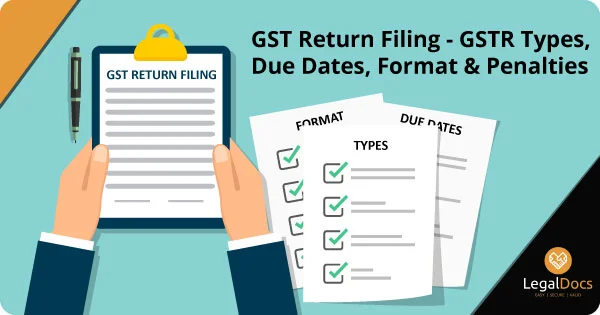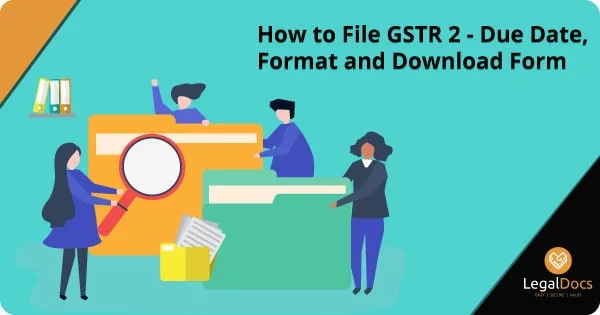GST Return Filing - GSTR Types, Due Dates, Format & Penalties
What is GST Return (GSTR)?
Good and Services Tax is a solitary indirect tax collected on the supply of goods and services from the manufacturer to the buyer. GST is essentially a tax collected on the business expansion at each stage. Accordingly, the customer needs to pay just the GST charged by the last supplier. So basically GST means a tax which is levied on every Goods and service.
Then, What is GSTR??
A GSTR is Goods and Services Return. A GST return filing is a document which has the details of a taxpayer. GST filing is required for tax administration authorities for calculating taxpayers tax liabilities. In GSTR the taxpayer can file the GST return online as well as offline. The taxpayer needs to file GST returns which includes his Sales, Purchases, Output GST, Input Tax Credit. For filing of GST monthly return, you need to have GST complaint sales and GST purchase invoices.
Types of GST Returns (GSTR)
GST return must be documented by every taxpayer who has completed GST registration. There are basically 11 types of GST returns (GSTR). There are different types of GST filing forms for casual taxpayers, such as GSTR - 1, GSTR - 2. GSTR - 3, GSTR - 4, GSTR - 5, GSTR - 6, GSTR - 7, GSTR - 8, GSTR - 9, GSTR - 10, GSTR - 11.
GSTR 1 Return “ Sales Returns Due on 10th of Every Month
GSTR 1return forms must be recorded by an enrolled taxable person with points of interest of the outward supplies of goods and services. GSTR 1 is the monthly statement GSTR 1 includes debit notes, credit notes, details of invoices etc.
GSTR 1 due date is on 10th of every month. Later the taxpayer may not be allowed to file the details.
GSTR 1 should be filed by Input service distributor, Non - resident taxable person, Person paying tax under section 10 - Person opting for Composition Levy, Person required to deduct tax at source - person paying tax under section 51, Person required to collect tax at source - person paying tax under section 52.
More information on How to file GSTR 1?
GSTR 2 Return “ Purchase Returns Due on 15th of Every Month
GSTR 2 is the return form which is included with monthly details of purchase and sales of goods and services which is included with service effected claiming input credit tax.
GSTR 2 due date is before 15th of every month. Later the taxpayer may not be allowed to file the details. A Registered person needs to submit the details of inward supply and it should be filed by Non - Resident Taxable Person, Input Service Distributor, the Person paying tax under section 10 - person opting for Composition Levy, Person required to deduct tax at source - person paying tax under section 51. Person required to collect tax at source - person paying tax under section 52.
GSTR 3 Return “ Input Tax Credit Returns -Due on 20th of Every Month
GSTR 3 is the final form to filed by the taxpayer with the details including with the monthly return of the business. The Part A of GSTR 3 return will be generated automatically based on information furnished through FORM GSTR-1, FORM GSTR-2 and based on other liabilities of preceding tax periods. GSTR 3 due date is before 20th of every month. Later the taxpayer may not be allowed to file the details.
The taxpayer can submit his liability towards tax, interest, penalty, fees or any other amount payable under the Act and include the details in Part B of the return in FORM GSTR-3.
GSTR 3 should be filed by Input service distributor, Non-Resident Taxable person, Person paying tax under section 10 i.e. person opting for Composition Levy, Person required to deduct tax at source i.e. person paying tax under section 51, Person required to collect tax at source i.e. person paying tax under section 52.
More information on What is GSTR 3?
GSTR 4 Return “ Quarterly Return for Composition Suppliers Due on 18th
GSTR 4 is the form or a document which needs to be filed by every registered taxpayer who has signed up for composition scheme. GSTR 4 due date is before 18th of every month. Later the taxpayer may not be allowed to file the details.
The GSTR 4 should be filed by the Registered person paying tax under section 10 which means the person paying composition levy.
GSTR 5 Return “ Monthly Return for Non-Resident Taxable Persons
The GSTR 5 form is to be filed by registered but non-resident taxpayers. It is a periodic filing. The taxpayer must file information and details of outward supplies and inward supplies. This form includes expenses and incomes details.
GSTR 6 Return “ Monthly Return for Input Service Distributors
The GSTR 6 form is to be filed by a taxable person who is registered as the Input Service Distributor, it is a monthly filing. Input tax credit reverted, distributed or received as SGST, CGST, and IGST.
GSTR 7 Return “ Monthly Return for Tax Deductors
GSTR 7 has to be filed by the tax deductor, which includes the details about the deducted tax. The tax deductor needs to provide the details of TDS amount in his return filing.
When the amount of TDS is paid, it is reflected in the credit ledger.
GSTR 7 should be filed by the Registered person required to deduct tax under section 51.
GSTR 8 Return “ Monthly Return for E-Commerce Operator
GSTR-8 is for E-commerce companies which should be done every month. A business which takes place online and for distribution of goods and services comes under GSTR - 8.
GSTR 9 Return “ Annual GST Return
GSTR 9 is for the taxpayer who has chosen the Composition Scheme. It is the annual filing done by the taxpayer.
GSTR 10 Return “ Final GST Return
GSTR 10 is the final form or filing done by the taxpayer whose form has been surrendered or canceled.
GSTR 11 Return “ GST Return for UIN Holders
GSTR 11 is the filing done by the one who has issued UIN (Unique Identity Number) and inward tax paid are claimed.
How to File GST Return (GSTR)?
Every single taxpayer such as manufacturers, dealers, consumers should file their GST on regular basis, it can be done monthly or periodically. In the new GST regime, the GST return process for filing has become very lenient. There are two ways for GST return filing process where you can complete it online as well as offline. Nowadays there is a huge possibility to do GST return filing procedure online, using different types of Software and applications and various online websites, they will auto-populate the details on each GSTR forms. Following mentioned are easy steps to know the process how to file GST Return (GSTR):
- Visit the GST registration portal www.gst.gov.in
- A 15-digit GST identification number (GSTIN) will be issued based on your state code and PAN number.
- Upload invoices on the GST portal or the software. An invoice reference number will be issued against each invoice.
- After uploading invoices, outward return, inward return, and cumulative monthly return have to be filed online. If there are any errors, you have the option to correct it and refile the returns.
- File the outward supply returns in GSTR-1 form through the information section at the GST Common Portal (GSTN) on or before 10th of the following month.
- Details of outward supplies furnished by the supplier will be made available in GSTR-2A to the recipient.
- The Recipient has to verify, validate, and modify the details of outward supplies, and also file details of credit or debit notes.
- The Recipient has to furnish the details of inward supplies of taxable goods and services in GSTR-2 form.
- The supplier can either accept or reject the modifications of the details of inward supplies made available by the recipient in GSTR-1A.
Due Dates for GST Returns
There are multiple GST returns and GST due dates accordingly, in common there are 11 types of GST such as GSTR 1, GSTR 2. GSTR 3, GSTR 4, GSTR 5, GSTR 6, GSTR 7, GSTR 8, GSTR 9, GSTR 10, GSTR - 11.
Goods and Services Return | GST Due dates |
GSTR 1 | 10th of every month |
GSTR 2 | 15th of every month |
GSTR 3 | 20th of every month |
GSTR 4 | 18th of every month |
GSTR 5 | 20th of every month |
GSTR 6 | 13th of every month |
GSTR 7 | 10th of every month |
GSTR 8 | 10th of every month |
GSTR 9 | 31st Dec of every financial year |
GSTR 10 | Within 3 months of the date of cancellation |
GSTR 11 | 28th of the month following the month for which statement is filed |
Note: GST Council may change the dates of return filing which will be reflected on the GST portal
Due dates for GST returns based on Latest orders.
- Quarterly Returns (Taxpayers who opted for composition scheme with Annual Turnover up to Rs. 1.5 Crore can opt for quarterly return filing)
GST type | Quarterly period | GST due dates |
GSTR 1 | January 2018 - March 2018 | 30th April 2018 |
April 2018 - June 2018 | 31st July 2018 | |
July 2018 - September 2018 | 31st Oct 2018 |
Turnover exceeds 1.5 crore
Period | GST due dates |
July to Nov | 10th Jan 2018 |
Dec | 10th Feb 2018 |
Jan 2018 | 10th Mar 2018 |
Feb 2018 | 10th Apr 2018 |
March 2018 | 10th May 2018 |
April 2018 | 31st May 2018 |
May 2018 | 10th June 2018 |
June 2018 | 10th July 2018 |
July 2018 | 11th August 2018 |
August 2018 | 11th Sept 2018 |
GSTR 2 and GSTR 3
- GSTR-2 and GSTR-3 filing currently suspended for some time.
GSTR 3B
- GSTR 3B has been extended to 31st March 2019
- All businesses have to file GSTR-3B by 20th of next month until March 2019.
GSTR 4
- The due date for the quarter April 2018 to June 2018 is 18th July 2018
- The due date for the quarter July 2018 to Sept 2018 is 18th Oct 2018GSTR-5
- The due date for Aug 2018 is 20th Sept 2018GSTR-5A
- The due date for Aug 2018 is 20th Sept 2018
GSTR 6
- Due date of GSTR-6 for the months from July 2017 to Aug 2018 is extended to 30th Sept 2018
Other Due Dates
TRAN-02 “ 30th June 2018
- Latest update as on 10th Sept 2018, TRAN-01 and TRAN-02 for taxpayers who faced tech glitches and could not file forms have time till 31st March 2019 and 30th April 2019 to complete filing these forms. Government notifies that GST payment due date is from July 18-March 19.
GST Penalty & Late Fees
- The interest is calculated as 18\\% per annum on the due date for GST payment. It has to be calculated by the taxpayer on the amount of outstanding tax to be paid.
- The late fees are rupees 100 per day and it is liable for per Act. The maximum amount is 5000 rupees. The late fees of rupees 100 are only for SGST, CGST, this is not for IGST.
- For late filing of GSTR-1, GSTR-3B, GSTR-4, GSTR-5 & GSTR-6 after the due date is Rs. 50 per day of delay is GST penalty for late filing.
- For NIL returns the late fees is 20 rupees per day as GST penalty. This penalty is for GSTR-1, GSTR-3B and GSTR-4 & GSTR-5.
 Knowledge Center
Knowledge Center


























LEAVE A REPLY: